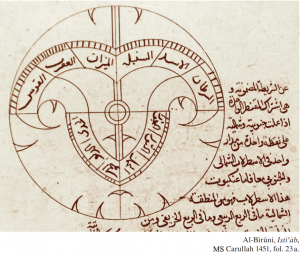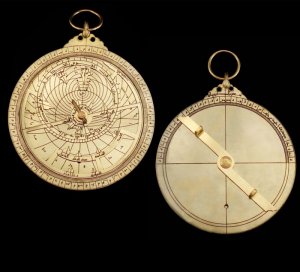
A forum on astrolabe: getting to grips with an ancient Islamic astronomical instrument

Besides ability to provide precise measurements of altitude, local time, and position of starts, al-Khujandi’s astrolabe is of astounding beauty. Credit: The Museum of Islamic Art, Doha: Marc Pelletreau (SI.5.1999).

Arabic manuscript expounding an astrolabe shape of crab or Arabic 'Salta'oon'. Credit: Science and Technology in Islam, vol. II (Astronomy), Institute for the History of Arabic-Islamic Science at Frankfurt, Germany.

A computerized model of al-Khujandi's astrolabe, through which scientists can demonstrated how easily it could function as a kind of a rudimentary analogue. Credit: Wilfred de Graaf, Utrecht University
Scientists illustrate through computerized models how Medieval Arabs and Muslims used their astronomical instruments.
SHARJAH, EMIRATE OF SHARJAH, UNITED ARAB EMIRATES, December 10, 2024 /EINPresswire.com/ -- The University of Sharjah hosted an astrolabe workshop in which western scientists showed participants how an astronomical instrument made by an ancient Muslim scholar nearly 1,000 years ago measured the altitude of the sun throughout the twelve zodiacal signs and told local time through the position of the sun in the ecliptic on a given day.
The workshop was an opportunity to train a host of Arab and Muslim academics on how their forefathers constructed their own astronomical instruments and the methods they used in those ancient days for timekeeping, scheduling of the five different times of Muslim prayers, and determining altitudes and positions of the brightest stars in the sky and at different times of the year.
The workshop was part of a one-day forum held late in November, showcasing a 10th century astrolabe constructed by an Arab and Muslim astronomer known in Western astronomy circles by the surname al-Khujandi. His full name in Arabic is Abu Maḥmud Ḥamid ibn al‐Khiḍr al‐Khujandi.
In the ninth century, Muhammad ibn Musa Al-Khwarizmi, the famous Muslim astronomer, better known simply Al-Khwarizmi, whose name survives in the word algorithm, added geometrical methods of drawing azimuth circles, and al-Khujandi was one of the first astrolabe makers who actually constructed such azimuthal circles in practice.
Al-Khujandi’s original astrolabe, considered to be one of the most important surviving astronomical instruments in the world, is part of the prized artifacts of the Museum of Islamic Art in Doha, Qatar.
In a plenary presentation, Dutch mathematician and historian of science, Jan Pieter Hogendijk, elaborated on the astrolabe as a precision instrument and a structure governed to a large extent by mathematical laws.
“As far as we know, al-Khujandi was the first Islamic instrument builder who fully obeyed the mathematical laws and at the same time introduced artistic elements in the construction of the astrolabe,” said Prof. Hogendijk, who is also member of the Royal Netherlands Academy of Arts and Sciences.
“He (al-Khujandi) stands at the beginning of the Islamic tradition of extreme beauty in astrolabe construction. Also interesting is the fact that he was a theoretical scholar and a practical instrument maker at the same time.”
Believed to have been invented in ancient Greece at the end of the 3rd century CE, the astrolabe was developed and refined by Arab and Muslim scholars in the Middle East. It was the Arabic astrolabe that reached medieval Europe around the 12th century, as did the globe, another highly practical and useful Arab navigational instrument. Some extant European medieval manuscripts show astrolabe drawings in both Arabic and Latin.
The names of the brightest stars in the sky are designated letters of the Greek alphabet in European languages, but in reality, most of them are transcriptions derived from the Arabic alphabet. Scientists list more than 200 names of the brightest and most visible stars to have been adopted in Europe without translation from the pronunciation of the Arabic names Arab astronomers gave to them.
Prof. Hogendijk’s interest in Islamic astrolabes goes back to 1988 when he started holding “interactive astrolabe workshops. I chose an old Islamic astrolabe, for example, a Yemeni astrolabe from the 12th century, and drew by hand a somewhat simplified model of two parts of the instrument on paper. These two drawings I copied on paper and plastic, paying close attention to the size, and then I put the paper and plastic parts together.”
To generate academic and popular interest in the Islamic astrolabe, Prof. Hogendijk started holding workshops in numerous Islamic countries. The original astrolabes discovered so far are unaffordable and inaccessible as they are among the priceless possessions of world museums. To supplement his teaching, Prof. Hogendijk produced an affordable model of an Islamic astrolabe to use in his workshops. The model was constructed of paper and plastic with a pin rotating over the paper part.
“I often taught astrolabe workshops in Islamic countries and then prepared and took with me 200 models (the cost of 50 euros was easy to manage) - so I could teach the workshop ten times to audiences of 20 people at most.
“I gave an astrolabe model to each participant, let them solve exercises with it, and then let each participant take the models home and show them to their friends. This generated much enthusiasm for the astrolabe and for Islamic science in general.”
In 1995, when research for first time threw ample light on al-Khujandi’s astrolabe, Prof. Hogendijk decided to discard his old hand-drawn astrolabe models. “I decided to draw by hand a new model based on al-Khujandi’s astrolabe. This was really an exercise in humility - if you try to draw the astrolabe parts yourself by hand, you start to realize and admire the incredible expertise of the old masters”.
In 2005, Wilfred de Graaf, Education Coordinator at Utrecht University, programmed for the first time a computer-drawn model that closely resembled al-Khujandi’s astrolabe. The computerized model could be easily adapted to the geographical altitude of any city in today’s world.
Since then, Prof Hogendijk and de Graaf have collaborated on these workshops, using the computer-programmed model. “For didactic reasons, the computer-drawn model is simpler than al-Khujandi’s astrolabe itself,” he goes on.
Al-Khujandi’s astrolabe is essentially a clock, notes Prof. Hogendijk, with a 24-hour dial, using the sun instead of the modern hand. “The sun shows the time as the hand in the modern clock. The time is local true solar time, noon is exactly 12 hours.”
With al-Khujandi the astrolabe became mathematical art, maintained Prof. Hogendijk, exhibiting “a spider with ecliptic (with the 12 signs) and precisely computed stars and star names, just as in other astrolabes. Some star pointers are heads of birds, other star pointers are leaves.”
Besides its ability to provide precise measurements of altitude, exact local time, and position of shining starts, al-Khujandi’s astrolabe is of astounding beauty, adds Prof. Hogendijk, with its decorative throne (top of the astrolabe), fascinating Arabic script, two lion’s heads and a horse to fix the spider into the plate.
de Graaf gave a presentation of his computer-designed model of al-Khujandi’s astrolabe and demonstrated how easily it could function as a kind of a rudimentary analogue computer with the ability to measure the altitude of heavenly bodies and locate the position of the sun and the brightest stars in relation to the meridian and the horizon. Besides, he said, the astrolabe was as a clock to measure time.
He emphasized that al-Khujandi’s astrolabe “is one of the oldest and beautifully decorated instruments extant today.” In numerous exercises on his computerized model of al-Khujandi’s astrolabe, he showed how the instrument could determine the length of day and night and the local time, locate stars and their movements, or measure the altitude of the sun by “using the alidade on the back side of the astrolabe.”
Mesut Idriz, Sharjah University’s Professor of Islamic civilization, and the organizer, said the forum’s presentations and workshop “provided a link between the artistic and scientific traditions in Islamic civilization. Similar connections can be seen in, for example, artistic pictures of stellar constellations, plants and animals in Arabic manuscripts; and also in Islamic geometric decorations on historic buildings such as mosques and palaces.”
Al-Khujandi is not known to have used statistics, however, Prof. Idriz said “his scientific methodology looks very modern because of his care in deriving scientific conclusions from incomplete data. For example, he could make an accurate observation of the altitude of the sun above the horizon only once a day, when it was exactly at noon.
“Nonetheless, he was able to use these observations in order to find the maximum distance of the sun to the equator which could happen any time of day. He was also able to deal with the fact that on some days, astronomical observations are impossible because the sky is clouded.”
LEON BARKHO
University Of Sharjah
+971 50 165 4376
email us here
Distribution channels: Book Publishing Industry, Culture, Society & Lifestyle, Education, Science, World & Regional
Legal Disclaimer:
EIN Presswire provides this news content "as is" without warranty of any kind. We do not accept any responsibility or liability for the accuracy, content, images, videos, licenses, completeness, legality, or reliability of the information contained in this article. If you have any complaints or copyright issues related to this article, kindly contact the author above.
Submit your press release

